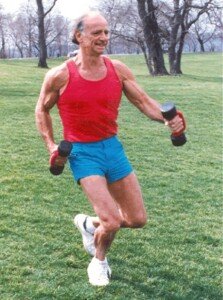
For people with a thoracic aortic aneurysm, there’s a weightlifting modality that can burn fat & tone muscle: panaerobics.
If you’ve been diagnosed with a thoracic aortic aneurysm and now think that your dreams of achieving a “buff” body have been crushed, there is still hope!
There is a type of exercise called panaerobics, which means whole body aerobics. However, there is a twist: a resistance component.
This component is safe for those with a thoracic aortic aneurysm, because the resistance is far less than the weightlifting restrictions that patients are typically given by their physicians — to guard against an aortic dissection.
“The wall of the aorta has five layers which are (from inner to outer): intima, elastic lamina, media, another elastic lamina, adventitia,” says Dr. David Beatty, MD, a retired general practitioner with 30+ years of experience and an instructor of general medicine for 20 years.
“A dissection of the aorta usually follows a disruption or tear of the inner wall — the intima.”
For panaerobics, the weight range that is held in each hand can be from from two pounds to 10 pounds.
Aerobic Exercise and Thoracic Aortic Aneurysm
The American Heart Association journal, Circulation, states (in reference to aortic aneurysm): Aerobic exercise is generally safe, provided the patient does not have a hypertensive response to exercise.
Hypertensive means substantial blood pressure increase. This usually isn’t the case with aerobics, but when it is, the aerobics are of a more significant nature such as running and hard cycling.
With panaerobics, we are talking walking and calisthenics.
But if you have an aortic aneurysm and are concerned about a hypertensive response to even walking, ask your doctor to be tested for this with a stress test.
If it’s normal, have a repeat test except while holding two-pound weights in each hand. If that’s normal, take it again with three- or five-pound weights.
“Panaerobics” was coined by Dr. Leonard Schwartz. He conducted major amounts of research at the Human Energy Research Laboratory at the University of Pittsburgh on the muscle loading behind panaerobics.

Dr. Leonard Schwartz
This training style results in very efficient muscles in which strength, speed, power and endurance are developed. The objective is to load as much muscle as possible, all at the same time.
How to Do Panaerobics
The legs are in continuous motion – the aerobics component. The most basic form of panaerobics is the so-called “heavy hands” walking.
But that’s just the foundation. In panaerobics, there should be a “verticality” to the upper body movements.
So rather than just swing or pump the arms (while holding weights) while walking, you are performing shoulder pressing motions, side raises and even pushing the weights out before your body to work the chest muscles. Don’t forget biceps curls and triceps extensions.
You can combine these also: shoulder press to biceps curl, shoulder press to biceps curl.
What worked best for Dr. Schwartz (who, by the way, did not have a diagnosed aortic aneurysm), were multiple 10-15 minute panaerobic sessions per day.
Though if you prefer, you can do one 60 minute session per day.
When he was 82, Dr. Schwartz still had a muscled physique and 5 percent body fat.
Brisk walking isn’t the only aerobic component; while working the upper body, you can also simultaneously perform stationary or walking lunges, lateral lunges, squats, high knee marches in place or marching back and forth, kicking and jogging in place.
You can do panaerobics every day totaling an hour, though a few days’ off per week are fine if you prefer.
Those with aortic aneurysm can bring panaerobics to the step class room; while doing a step class, you hold weights while doing the arm choreography.
Whether you have an aortic aneurysm or not, use two pound weights when first starting out with panaerobics. As already mentioned, you should get the use of these cleared with your physician by getting a blood pressure response tested.
Two pounds may sound negligible, but continuously moving your arms (upward and forward presses, backward presses, high swings, lateral raises) for 30 minutes straight while holding these weights may tax you.
Though the fatigue may be quite generous, this would not normally translate to a blood pressure spike, which those with aortic aneurysm must avoid.
Blood pressure spikes come from straining with heavy weights (“heavy” of course, being relative to that individual).
If you have a thoracic aortic aneurysm and want a safe fat-burning routine involving the use of resistance, try panaerobics.
 Dr. Beatty has worked in primary medicine, surgery, accident and emergency, OBGYN, pediatrics and chronic disease management. He is the Doctor of Medicine for Strong Home Gym.
Dr. Beatty has worked in primary medicine, surgery, accident and emergency, OBGYN, pediatrics and chronic disease management. He is the Doctor of Medicine for Strong Home Gym.
 Lorra Garrick is a former personal trainer certified through the American Council on Exercise. At Bally Total Fitness she trained women and men of all ages for fat loss, muscle building, fitness and improved health.
Lorra Garrick is a former personal trainer certified through the American Council on Exercise. At Bally Total Fitness she trained women and men of all ages for fat loss, muscle building, fitness and improved health.
.
Top image: Shutterstock, joyfuldesigns











